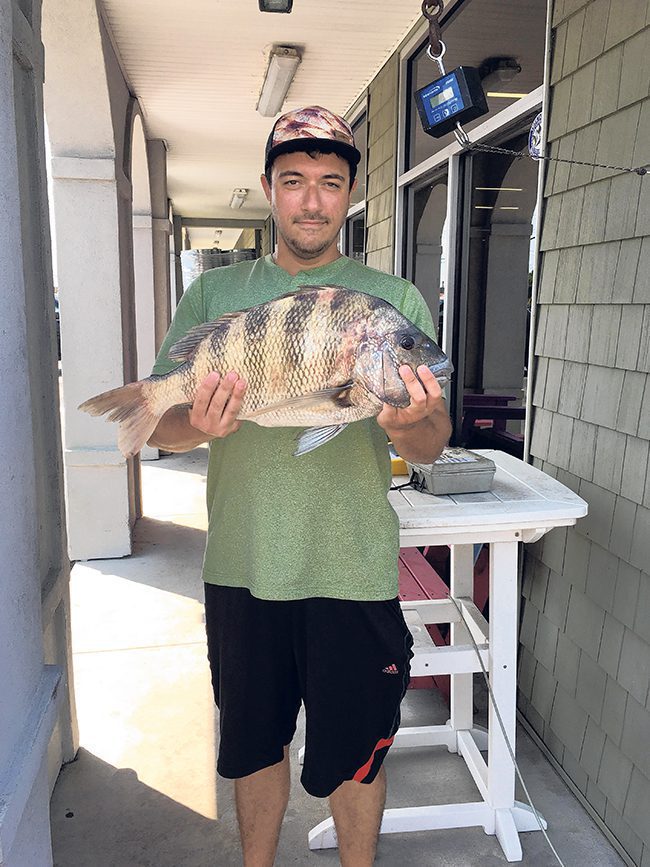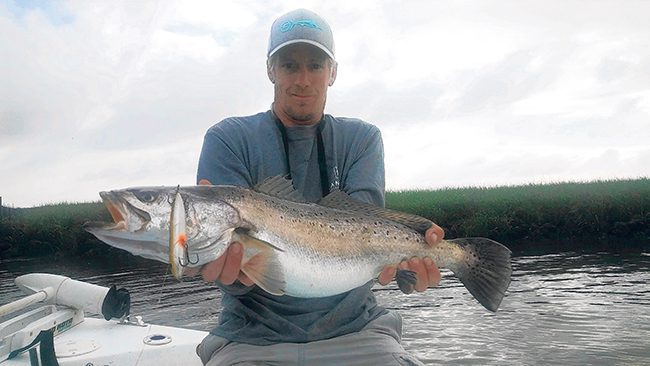Releases – June 21, 2018
The spotted seatrout fishing season will reopen in North Carolina waters Friday, June 15.
The recreational bag limit will be four-fish per person per day, and the minimum size limit will be 14 inches total length. All undersized or over the daily harvest limit fish caught must be immediately returned to the waters where taken, regardless of the condition of the fish.
For more specific recreational spotted seatrout fishing regulations, see FF-23-2018 on the N.C. Division of Marine Fisheries’ proclamations webpage.
The commercial size limit is 14 inches total length, as well, but the commercial harvest limits and fishing days differ by water body and gear type. For specific regulations, commercial fishermen should see FF-24-2018 on the division’s proclamations webpage.
The division closed all coastal and joint waters to commercial and recreational spotted seatrout harvest on Jan. 5 due to widespread cold stun events.
Cold stuns are natural events that occur when there is a sudden drop in water temperature or prolonged periods of cold weather that makes the fish sluggish. During a cold stun, many fish die from the cold or fall prey to birds and other predators. Studies suggest that cold stun events can have a significant impact on spotted seatrout populations.
Under the N.C. Spotted Seatrout Fishery Management Plan, if a significant cold stun event occurs, the Division of Marine Fisheries closes all spotted seatrout harvests until June 15 to allow the fish that survive the cold stun event the chance to spawn in the spring before harvest reopens. Peak spawning occurs in May. The N.C. Wildlife Resources Commission automatically closes spotted seatrout season in inland waters when it closes in adjacent coastal waters.
For more information on cold stun events, see the division’s Cold Stun Facts webpage.
For more information, contact division spotted seatrout biologist Steve Poland at (252) 808-8159 or Steve.Poland@ncdenr.gov.

Zach Costas, from Carolina Beach, with a citation sheepshead caught near the Carolina Beach state park on a fiddler crab. The fish weighed 8 lbs., 6 oz. at Island Tackle.
The amount of fish and shellfish fishermen sold at North Carolina docks declined last year, due in large part to a drop in hard blue crab landings. But shrimp landings remained at a record high for the second straight year.
Fishermen sold 54.4 million pounds of fish and shellfish to North Carolina seafood dealers in 2017, a 9.3 percent drop from 2016 and 7 percent lower than the previous five-year average. However, the $96.5 million estimated dockside value of the 2017 landings was 2.6 percent higher than the value of the landings in 2016.
Contributing to the decrease in overall landings was a fall in hard blue crab landings. Fishermen sold 18 million pounds of hard blue crabs at North Carolina docks in 2017, which was 26.9 percent lower than in 2016 and 25 percent lower than the previous five-year average. The estimated dockside value of hard blue crab landings dropped by 14.3 percent to $17.8 million.
Alternatively, fishermen landed 427,753 pounds of soft blue crabs in 2017, an increase of 50.2 percent over 2016 and 20.3 percent over the previous five-year average. Peeler blue crab landings increased by 74 percent over 2016 and 29.5 percent over the previous five-year average.
Hard blue crab remained the top marine fisheries species landed in North Carolina, followed by shrimp at 13.9 million pounds.
While shrimp landings increased by only 5 percent from 2016, they remained the highest since the N.C. Division of Marine Fisheries’ Trip Ticket Program began in 1994, and were 34 percent higher than the five-year average.
Rounding out the top five species landed last year were summer flounder (1.6 million pounds), bluefish (1.5 million pounds), and southern flounder (1.4 million pounds).
While not in the top five, 2017 landings of black drum and red drum more than doubled from 2016 landings, which can be attributed to a strong year classes in previous years. A year class is fish in a stock that were born in the same year.
Landings of spiny dogfish, cobia, and Atlantic croaker decreased in 2017.
The Division of Marine Fisheries’ Trip Ticket Program collects commercial fishing landings statistics through legislatively-mandated reporting of all fisherman to dealer transactions.
Landings can fluctuate from year-to year based on many factors, including environmental conditions, market changes and fishing effort.
For a full landings report, click on the 2017 Annual Fisheries Bulletin link at http://portal.ncdenr.org/web/mf/marine-fisheries-catch-statistics.

Chris Hanson, of Wilmington, with an 8 lb. trout caught on a XCalibur one knocker topwater bait. He was fishing with Capt. Jamie Rushing of Seagate Charters.
Coastal recreational anglers caught and kept fewer fish last year than in 2017, likely due in part to bad weather days during prime fishing season that kept surf fishermen off the water.
Coastal anglers caught and kept more than 5.5 million fish with an estimated total weight of 11 million pounds in North Carolina in 2017, according to estimates from the N.C. Division of Marine Fisheries’ Coastal Angling Program. That was about 35.7 percent fewer fish (8.1 percent fewer pounds) than in 2016.
The decrease in landings correlates with a 16 percent reduction in the total number of fishing trips taken, including a 39 percent drop in the number of beach/bank fishing trips. The greatest decrease in fishing trips came during September and October, when Hurricane Jose and Hurricane Maria passed offshore.
Key species with decreased landings included bluefish (55.5 percent), Atlantic croaker (34 percent), dolphin (29 percent), kingfishes (36.6 percent), pinfish (36 percent), pigfish (67.5 percent), and puffers (52.6 percent). These species represented 56 percent of the overall drop by number.
On the other hand, increases in the number of fish landed were seen in some species, including red drum (63.4 percent), pompano (12 percent), and yellowfin tuna (42.3 percent).
The top five species landed in 2017 by number were: kingfishes (551,861), bluefish (524,072), spot (469,462), spanish mackerel (439,654), and spotted seatrout (339,523).
The top five species landed by weight were: yellowfin tuna (3 million pounds), dolphin (1.5 million pounds), bluefish (690,018 pounds), spotted seatrout (580,849 pounds), and wahoo (497,341 pounds).
The Division of Marine Fisheries estimates recreational fishing harvests through broad-based intercept surveys, where port agents talk to fishermen on the beach, at the piers and at boat ramps, and through mail surveys to license holders.
For a full landings report, click on the 2017 Annual Fisheries Bulletin link at http://portal.ncdenr.org/web/mf/marine-fisheries-catch-statistics
A new web application on the Division of Marine Fisheries website will help fishermen find what shellfishing waters are open or closed to harvest in real time.
The new app debuts on the division’s website June 15.
One of the main missions of the division’s Shellfish Sanitation and Recreational Water Quality Section is to make sure that all shellfish harvested from North Carolina waters are safe to eat. To accomplish this, the section regularly tests shellfishing waters for the presence of fecal bacteria, surveys the shoreline area for the presence of potential pollution sources, and conducts studies on point source discharges of pollution, among many other things. All of the data collected is then used to determine the proper classifications for state shellfish growing areas.
Studies show that bacteria concentrations in some shellfish harvesting areas can become elevated following heavy rainfall, as fecal contaminants are washed from the ground surface, through stormwater ditches, and into the estuaries. As the shellfish feed, they can filter these fecal contaminants into their digestive system and concentrate them to a level that could cause severe illness if they are harvested and eaten raw. For these areas, management plans have been developed that require automatic temporary closures for shellfishing after certain rainfall thresholds are exceeded. These temporary closures remain in place until water quality sampling shows that bacteria concentrations have dropped to levels where shellfish harvesting is once again safe.
These temporary closures and reopenings are conveyed to the public through written proclamations that describe the boundaries of the temporarily closed shellfishing waters. While these written proclamations will remain the official, legal source for temporary closure descriptions, this new application is intended to help fishermen to visualize the closures in real time in a user-friendly way that is available on desktop computers, tablets, and cell phones.
The public can access the map through the division’s website at this link. It shows permanently closed shellfish harvest areas, as well as areas temporarily closed due to rainfall and stormwater runoff or other causes of short-term contamination like wastewater spills. Users can navigate throughout the coast to view different closure areas or use the location search tool in the top right-hand corner of the screen in order to navigate directly to an area of interest.





